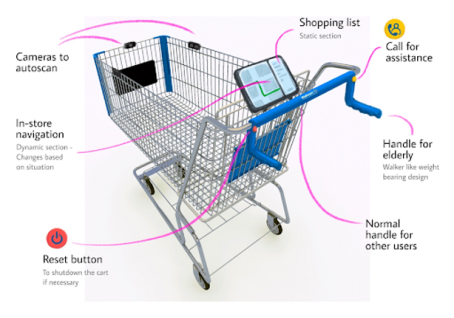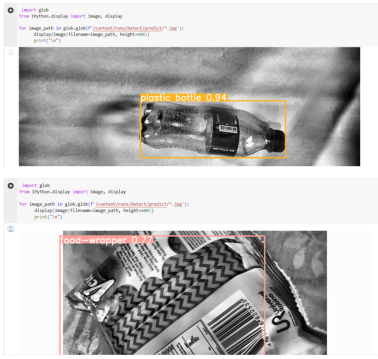The article endeavors to redefine the shopping cart paradigm and investigate the possibilities of machine vision by creating, implementing, and assessing a Smart Shopping Cart Management System. It aims to improve the product recognition process of self-scanning machines in supermarkets by employing Machine Vision technology.
Keywords: management system, system design, smart shopping cart, machine vision, pattern recognition, YOLOv8
Introduction
The retail industry is currently facing a critical juncture characterized by ongoing technological advancements that are reshaping consumer experiences and behaviors. In recent decades, the advent of e-commerce, digital payment systems, and data analytics has significantly altered the shopping landscape, offering enhanced convenience, customization, and operational effectiveness within the retail sector. Despite the digital transformation, brick-and-mortar retail establishments continue to play a vital role in the customer experience, delivering tangible interactions, sensory engagements, and interpersonal connections that online channels are unable to entirely emulate [1].
The aim of this research is to redefine conventional shopping cart model and investigate the capabilities of computer vision by creating, implementing, and assessing a Smart Shopping Cart Management System (SSCMS). By employing computer vision for real-time object detection, recognition, and tracking, SSCMS is designed to streamline the shopping process, tailor to individual preferences, and enhance traditional shopping carts with smart functionalities to enhance the operational efficiency of retailers. Furthermore, this study was prompted by the acknowledgment of the diverse advantages that SSCMS can offer to both retailers and customers [2].
Methodological studies of system requirements
System overview
The Smart Shopping Cart Management designed a Machine Vision framework is intended to accurately identify and categorize items within a grocery store environment. By leveraging the YOLOv8 algorithm, known for its fast speed and accuracy, the framework can perform real-time detection of items [3]. This functionality enables various operations such as inventory management, assisting with self-service checkouts, and analyzing customer shopping behaviors. Deployed on a cloud infrastructure, the system takes advantage of scalable resources and strong security measures.
Overview of the smart shopping cart management system
Smart shopping carts enable customers to navigate the store seamlessly by scanning products and automatically detecting items added to the cart. The system maintains an ongoing tally of purchases, providing real-time expenditure updates to customers. This feature eliminates unexpected costs at the checkout counter. Upon completing their shopping, customers can conveniently settle their bill using various a variety of options. methods. Additionally, these carts are equipped a range suite features, retailers’ measures, alleviating concerns theft for retailers.
By employing artificial intelligence and machine learning algorithms, intelligent shopping has the capability to assess an individual's shopping patterns and inclinations. Subsequently, these carts can offer suggestions by taking into account the user's prior purchases, search history, and browsing activities. This personalized approach ensures a tailored shopping experience that aligns with the user's unique requirements and preferences. The recommendations are seamlessly integrated into the browsing experience within the smart shopping cart or application, facilitating the discovery of products that are likely to be of interest to the user.
Proposed shopping cart management system
In order to expedite the checkout process, a proposal has been made for the implementation of an on-board smart item recognition system. This sophisticated mobile cart will be equipped with a camera, RFID-RC522, Raspberry Pi 4, LCD screen, and a weight sensor (Figure 1).

Fig. 1. Example of smart cart system components
Initially, the customer is required to scan the QR-code on the cart using their mobile phone to establish a connection between the cart and their device, enabling the cart to transmit the billing details. The intelligent cart autonomously scans the barcodes of items placed within it using the camera input.
The camera input, in conjunction with the weight sensor, determines whether items are being to or removed from the cart. To add an item to the list, the customer places the item in the cart, allowing the camera to scan the barcode and store the data of the respective items in a cloud database.
If the barcode is not visible, a machine learning model is utilized to identify the item. When removing an item from the cart, the customer simply needs to physically take out the unwanted item. During this process, the camera, in combination with the weight sensor, detects the changes and makes the necessary adjustments.
Upon completion of the shopping process, the billing phase commences. During this phase, a final bill is generated and presented to the customer on their device, where they can also proceed with the payment.
Hardware components
The hardware components of the smart shopping cart management system are essential for facilitating the seamless integration of machine vision technology and real-time data processing. These components are critical for capturing visual data, collecting information about items, and enabling communication between the shopping carts and the backend server infrastructure.
The hardware components of the smart shopping cart management system have been meticulously chosen and integrated to establish a resilient and effective platform for the real-time capture, processing, and analysis of visual data [4]. Through the utilization of sophisticated cameras, sensors, embedded computing devices, and connectivity modules, the system facilitates smooth interaction among customers, shopping carts, and the backend server infrastructure. This, in turn, enhances the shopping experience by providing personalized and efficient services.
Software framework
The software framework of the smart shopping cart management system serves as the foundation of the system's intelligence, enabling data processing, analysis, and user interaction.
The framework offers a resilient and expandable platform the real-time processing, analysis, and utilization of visual data. Through the utilization of machine vision algorithms, data analytics, and user interface elements, the system improves the shopping experience for customers, streamlines inventory management for retailers, and fosters business expansion within the retail sector.
Results and discussion
The prototype of the system successfully recognized specific products and packaging under real-world conditions, retrieved corresponding information from the database, updated the buyer's receipt, and generated an invoice for payment.

Fig. 2. Examples of cart items recognition on backend side
Examples of shopping cart items recognition on the backend side of designed system shown on Figure 2. Products automatically scanned upon placement in the cart, with a scanning speed of under 0.2 seconds. Total time interaction with the customer was less than 2 minutes.
Conclusion
The implementation of such a smart shopping system offers significant advantages to customers by alleviating the typical inconveniences experienced while shopping, particularly peak seasons. Customers can reduce waiting times at the checkout by utilizing this system. Through the mobile application, shoppers have access to essential product details prior to making a purchase. Additionally, the machine vision system aids in monitoring unpurchased items and mitigating potential losses. Furthermore, the utilization of object detection technology grants customers the flexibility to purchase and pay for their desired items accurately.
References:
1. J. Sales, J. V. Marti, R. Marin, E. Cervera, and P. J. Sanz, «CompaRob: The shopping cart assistance robot», Int. J. Distributed Sensors Networks, vol. 2016, Article ID 4781280, 2016. PP. 1–15.
2. Raju Kumar, K. Gopalakrishna, K. Ramesha on “Intelligent Shopping Cart” in International Journal of Engineering Science and Innovative Technology (IJESIT), 2013. PP. 499–507.
3. S. Ren, K. He, R. Girshick et al., «Faster R-CNN. Towards Real-Time Object Detection with Region Proposal Networks», in IEEE Transactions on Pattern Analysis & Machine Intelligence, 2017. PP. 1137–1149.
4. Y. J. Zuo, «Survivable RFID systems. Issues, challenges, and techniques», IEEE Trans. Syst., Man, Cybern. C, Appl. Rev, 2010. PP..406 -418.

